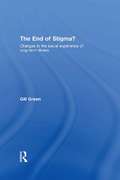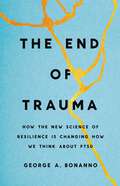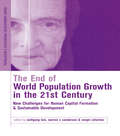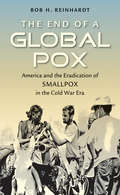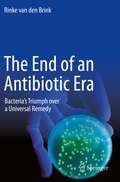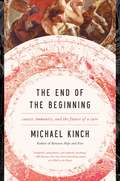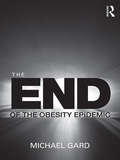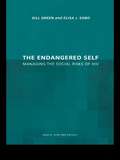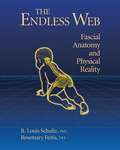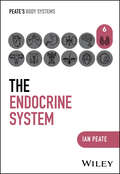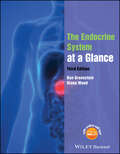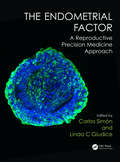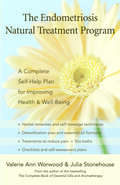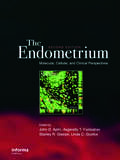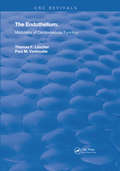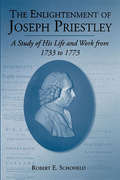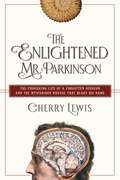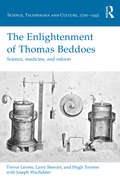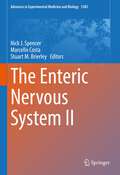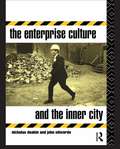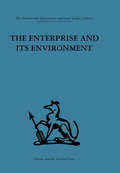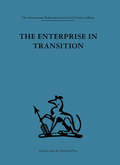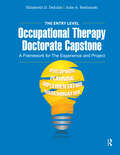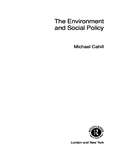- Table View
- List View
The End of Stigma?: Changes in the Social Experience of Long-Term Illness
by Gill GreenThis innovative book investigates the roots of contemporary experiences of stigma, throwing new light on the phenomenon by examining a variety of long-term conditions. Behaviour, lifestyle and identity are no longer the results of mass-production by social class and nation, but increasingly the quirky and unique eccentricities of the individual as consumer, reflexive citizen and free agent. But if the hallmark of the post-modern world is endless variety and unlimited sub-cultural freedom, should we not be witnessing "The End of Stigma"? The book takes Fukuyama’s notion of "The End of History" and examines contemporary challenges to the stigma associated with chronic illness. Award-winning author Gill Green examines cases of HIV, mental illness and substance misuse, to provide new insights into stigma in health. She demonstrates that people with long-term conditions refuse to be defined by their condition and highlights their increasingly powerful voice. The End of Stigma? will be of interest to a wide range of students and health professionals in medical sociology, health studies and social care.
The End of Trauma: How the New Science of Resilience Is Changing How We Think About PTSD
by George A. BonannoWith &“groundbreaking research on the psychology of resilience&” (Adam Grant), a top expert on human trauma argues that we vastly overestimate how common PTSD is in and fail to recognize how resilient people really are. After 9/11, mental health professionals flocked to New York to handle what everyone assumed would be a flood of trauma cases. Oddly, the flood never came. In The End of Trauma, pioneering psychologist George A. Bonanno argues that we failed to predict the psychological response to 9/11 because most of what we understand about trauma is wrong. For starters, it&’s not nearly as common as we think. In fact, people are overwhelmingly resilient to adversity. What we often interpret as PTSD are signs of a natural process of learning how to deal with a specific situation. We can cope far more effectively if we understand how this process works. Drawing on four decades of research, Bonanno explains what makes us resilient, why we sometimes aren&’t, and how we can better handle traumatic stress. Hopeful and humane, The End of Trauma overturns everything we thought we knew about how people respond to hardship.
The End of World Population Growth in the 21st Century: New Challenges for Human Capital Formation and Sustainable Development (Population and Sustainable Development)
by Warren C. SandersonThe 20th century was the century of explosive population growth, resulting in unprecedented impacts; in contrast, the 21st century is likely to see the end of world population growth and become the century of population aging. We are currently at the crossroads of these demographic regimes. This book presents fresh evidence about our demographic future and provides a new framework for understanding the underlying unity in this diversity. It is an invaluable resource for those concerned with the implications of population change in the 21st century. The End of World Population Growth in the 21st Century is the first volume in a new series on Population and Sustainable Development. The series provides fresh ways of thinking about population trends and impacts.
The End of a Global Pox: America and the Eradication of Smallpox in the Cold War Era (Flows, Migrations, and Exchanges)
by Bob H. ReinhardtBy the mid-twentieth century, smallpox had vanished from North America and Europe but continued to persist throughout Africa, Asia, and South America. In 1965, the United States joined an international effort to eradicate the disease, and after fifteen years of steady progress, the effort succeeded. Bob H. Reinhardt demonstrates that the fight against smallpox drew American liberals into new and complex relationships in the global Cold War, as he narrates the history of the only cooperative international effort to successfully eliminate a disease. Unlike other works that have chronicled the fight against smallpox by offering a "biography" of the disease or employing a triumphalist narrative of a public health victory, The End of a Global Pox examines the eradication program as a complex exercise of American power. Reinhardt draws on methods from environmental, medical, and political history to interpret the global eradication effort as an extension of U.S. technological, medical, and political power. This book demonstrates the far-reaching manifestations of American liberalism and Cold War ideology and sheds new light on the history of global public health and development.
The End of an Antibiotic Era: Bacteria's Triumph over a Universal Remedy
by Rinke van den BrinkIn this monograph, journalist Rinke van den Brink takes a closer look at the limitations and risks of today’s antibiotic use. Though all developed societies have grown accustomed to successfully treating bacterial infections with these wonder drugs, the author focuses on the increasing number of antibiotic-resistant infections. By examining recent mass outbreaks, readers will gain a better understanding of the global impact of antimicrobial resistance – one of the most serious public health threats today. Following this somewhat disquieting review of the status quo, interviews with a number of specialists provide an outlook on possible solutions. In a world that is more connected than ever, partnerships between different healthcare systems are becoming all the more important. Rinke van den Brink uses the example of a border-spanning collaboration between the Netherlands and Germany to demonstrate how effective lines of communication can be established. The book offers a wealth of useful background information for healthcare personnel. Not only does it share insights into the functional microbe-antibiotic relationship; it also discusses how clinics can effectively address outbreaks, helping readers to learn from past experiences and develop effective new strategies.
The End of the Beginning: Cancer, Immunity, And The Future Of A Cure
by Michael KinchA fascinating history of our understanding and the treatment of cancer by one of the leading figures in the field—who is also a pioneer on the cusp of a breakthrough. For the first time since a 5th century Greek physician gave the name “cancer” (karkinos, in Greek) to a deadly disease first described in Egyptian Papyri, the medical world is near a breakthrough that could allow even the most conservative doctors and pragmatic patients to use the other “c word” – cure – in the same sentence as cancer. A remarkable series of events has brought us to this point, thanks in large part to a new ability to more efficiently harness the extraordinary power of the human immune. The End of the Beginning is a remarkable history of cancer treatment and the evolution of our understanding of its dynamic interplay with the immune system. Through Michael Kinch’s personal experience as a cancer researcher at Washington University and the head of the oncology program at a leading biotechnology company, we witness the incredible accumulation of breakthrough science and its rapid translation into life-saving technologies that have begun to dramatically increase the quality and quantity of life for cancer patients. Expanding upon Kinch’s own remarkable projects to encompass the vaccines being deployed to eliminate cervical cancer, the development of cancer-specific “smart bombs” in the form of monoclonal antibodies, cellular therapies, and checkpoint inhibitors—The End of the Beginning reveals the incredible transformation of cancer treatment happening today. Kinch details the remarkable history of people, science, technology and disease and presents thrilling next-generation technologies that hold the promise to eliminate cancer for some, and perhaps ultimately, for all.
The End of the Beginning: Murder to Worldwide Celebrity (Sybil Norcroft Ser. #1)
by Carl DouglassSybil makes a serious mistake. Everyone who knows her or of her is aware that she and Attorney Paul Bel Geddes have locked horns for a decade, and each regard the other as the nemesis. Sybil's error is to get angry, then loud and demeaning, of Paul in a very public black tie New Year's Eve gathering after having received yet one more intent to sue 90 day letter" from the man. Her billionaire husband tries to shush her, but she all but shouted, "Don't patronize me, Charles. That bottom feeder has gone too far. Somebody needs to do something about him.""
The End of the Obesity Epidemic
by Michael GardDespite apocalyptic predictions from a vocal alliance of health professionals, politicians and social commentators that rising obesity levels would lead to a global health crisis, the crisis has not materialised. In this provocative follow up to his classic work of obesity scepticism, The Obesity Epidemic, Michael Gard argues that we have entered into a new, and perhaps terminal, phase of the obesity debate. Evidence suggests that obesity rates are levelling off in Western societies, life expectancies continue to rise in line with rising obesity rates, and across the world policy-makers have remained largely indifferent and inactive in the face of this apparently deadly threat to our health and well-being. Dissecting and dismissing much of the over-blown rhetoric and ideological bias found on both sides of the obesity debate, Gard demonstrates that the science of obesity remains radically uncertain and that it is impossible to establish an objective ‘truth’ on which to base policy. His powerful and inescapable conclusion is that we should now mark the end of the obesity epidemic. Offering a road map through the maze of claims and counter-claims, while still holding to a sceptical standpoint, this book provides an unparalleled anatomy of obesity as a scientific, political and cultural issue. It is essential reading for anybody with an interest in the science or sociology of health and lifestyle.
The Endangered Self: Identity and Social Risk
by Gill Green Elisa SoboTo date, the majority of HIV/AIDS research has concentrated on education and prevention for those with a seronegative status, while studies of HIV positive individuals have been concerned with their potential to infect others. The Endangered Self however, focuses on how the discovery of an HIV positive status affects the individual's sense of identity, on the experience of living with HIV and its effects on the individual's social relationships. In this comparative study of the UK and US, Green and Sobo explore identity change and the stigma attached to an HIV positive status within the context of the sociology of risk. Chapters discuss issues such as:*identity, social risk and AIDS*stigma*living and coping with HIV*the danger of disclosure*reported reactions in health care settings and sexual settings*risk and reality*seropositivity.The Endangered Self will be of interest to all those infected with HIV and to their families, partners, friends and caregivers who are affected by it. It will be essential reading for health-care professionals and those studying medical anthropology, sociology and health and risk studies.
The Endless Web: Fascial Anatomy and Physical Reality
by R. Louis Schultz Rosemary Feitis Ronald Thompson Diana SallesThe result of more than two decades of research and practice, The Endless Web presents in clear, readable language a comprehensive guide to understanding and working effectively with the myofascial system, the 'packing material' of the body. Myofascia is a flexible network of tissue that surrounds, cushions, and supports muscles, bones, and organs. It also acts as a riverbed containing the flow of interstitial fluid, and is a critical influence on the immune and hormonal systems. In daily life, this connective tissue is an underlying determinant of movement quality, modd, alertness, and general well-being. The Endless Web is a fully illustrated guide to understanding how myofascia works, it supportive role within the body's anatomy, and how gentle manipulation of the myofascial tissue is central to lasting therapeutic intervention and how it can be integrated into any bodywork practice.
The Endocrine System (Peate's Body Systems)
by Ian PeatePEATE???S BODY SYSTEMS THE ENDOCRINE SYSTEM A CONCISE, ILLUSTRATED, AND ACCESSIBLE GUIDE TO THE ENDOCRINE SYSTEM Each of the twelve volumes in Peate’s Body Systems series is rooted in the belief that a deep and thorough understanding of the human body is essential for providing the highest standard of care. Offering clear, accessible and up-to-date information on different body systems, this series bridges the gap between complex scientific concepts and practical, everyday applications in health and care settings. This series makes for an invaluable resource for those committed to understanding the intricacies of human biology, physiology and the various systems that sustain life. The Endocrine System is the perfect companion for students and newly registered practitioners across nursing and allied health fields with an interest in endocrinology, providing a comprehensive yet easy-to-digest guide for both academic and clinical application. Equips healthcare students and practitioners with the necessary information to provide safe and competent careFeatures colourful illustrations to aid comprehension, clarify complicated concepts, and render content more engaging and accessibleEmpowers readers to adapt to a rapidly evolving healthcare landscape, preparing them for the future of healthcare deliveryContains information necessary for effective patient care of those with hyper- and hypothyroidism, diabetes, and other diseases and conditions affecting the endocrine system
The Endocrine System at a Glance (At a Glance #42)
by Ben Greenstein Diana F. WoodThe Endocrine System at a Glance provides a highly illustrated and unambiguous introduction to the basic principles and mechanisms of endocrinology and the key endocrine organs, followed by sections on reproductive and metabolic endocrinology. Clinical scenarios contextualise the basic science and illustrate how endocrine conditions present, are diagnosed, and are treated on the wards. This third edition: Includes new material on basic diagnostic tests used in the diagnosis of endocrine disorders Features new material on cancer and endocrinology Includes MCQs for each chapter The Endocrine System at a Glance is ideal for all medical students studying endocrinology and revising for final exams, as well as preparing for clinical attachments. The book is also suitable for those training in allied health professions and nurses specialising in endocrinology.
The Endometrial Factor: A Reproductive Precision Medicine Approach
by Carlos Simón and Linda C. GiudiceAt the dawn of precision medicine, there is a new opportunity for novel approaches to understand, diagnose and treat endometrial disorders that affect fertility, reproductive outcomes, and women’s health more broadly. Herein, the editors have assembled critically evaluated state-of-the-art chapters presenting basic and clinical knowledge about the human endometrium that impacts or will impact clinical practice. All clinicians and researchers in Reproductive Medicine will find this book useful as a reference and a valuable tool for continued advancement in the understanding and management of the "endometrial factor".
The Endometriosis Natural Treatment Program: A Complete Self-Help Plan for Improving Health and Well-Being
by Valerie Ann Worwood Julia StonehouseBetween 10 and 15 percent of women suffer from endometriosis. Bestselling author Valerie Ann Worwood and health researcher Julia Stonehouse provide the definitive self-help natural treatment guide that can be used in conjunction with medical treatment to relieve the symptoms and help the body to heal.The program presents practical and easy-to-implement techniques that assist women in improving their overall health and well-being. The book explores the environmental toxins and other lifestyle issues that may contribute to endometriosis, and clearly explains simple ways to change these factors. Based on Worwood’s successful clinical practice, the authors’ multifaceted approach advocates specific natural health practices and a range of slow, steady lifestyle changes.
The Endometrium: Molecular, Cellular and Clinical Perspectives, Second Edition (Reproductive Medicine and Assisted Reproductive Techniques Series)
by John D Aplin Asgerally T Fazleabas Stanley R Glasser Linda C GiudiceThe first edition of The Endometrium was a landmark publishing event in reproductive biology and medicine. Many important developments have occurred in the field, and this new edition has been substantially updated and expanded to include new topics with an improved format. With the addition of several new authors and topics, the Second Edition of
The Endothelium: Modulator of Cardiovascular Function (Routledge Revivals)
by Thomas F. Luscher Paul M. VanhoutteFirst published in 1990: The Endothelium: Modulator of Cardiovascular Function takes a comprehensive look at the role of the endothelium in cardiovascular control in health and disease. Experts offer detailed reviews on specific topics that address these roles of the endothelium: diffusion barrier, blood-brain barrier, regulator of capillary permeability, metabolic function (uptake and enzymatic destruction), conversion of vasoactive products, production of prostanoids, production and release of endothelium-derived relaxing factors, production of endothelium-derived contracting factors, production of coagulation factors, production of fibrinolytic factors, reticulo-endothelial function, role in atherosclerosis, and changes in function with aging and disease. This overview provides the reader with an update on the role of one of the most fascinating cells in cardiovascular biology. It focuses on the multiple functions of those cells and offers the first attempt to draw a parallel between these functions. Anyone studying the fields of physiology and pharmacology will benefit from this "must have" reference resource.
The Enlightened Joseph Priestley: A Study of His Life and Work from 1733 to 1773
by Robert SchofieldJoseph Priestley (1733–1804) is one of the major figures of the English Enlightenment. A contemporary and friend of Benjamin Franklin and Thomas Jefferson, he exceeded even these polymaths in the breadth of his curiosity and learning. Yet no one has attempted an all-inclusive biography of Priestley, probably because he was simply too many persons for anyone easily to comprehend in a single study. Robert Schofield has devoted a lifetime of scholarship to this task. The result is a magisterial book, covering the life and works of Priestley during the critical first forty years of his life. <P><P>Although Priestley is best known as a chemist, this book is considerably more than a study in the history of science. As any good biographer must, Schofield has thoroughly studied the many activities in which Priestley was engaged. Among them are theology, electricity, chemistry, politics, English grammar, rhetoric, and educational philosophy. Schofield situates Priestley, the provincial dissenter, within the social, political, and intellectual contexts of his day and examines all the works Priestley wrote and published during this period. <P><P>Schofield singles out the first forty years of Priestley's life because these were the years of preparation and trial during which Priestley qualified for the achievements that were to make him famous. The discovery of oxygen, the defenses of Unitarianism, and the political liberalism that characterize the mature Priestley—all are foreshadowed in the young Priestley. A brief epilogue looks ahead to the next thirty years when Priestley was forced out of England and settled in Pennsylvania, the subject of Schofield's next book. But this volume stands alone as the definitive study of the making of Joseph Priestley.
The Enlightened Mr. Parkinson: The Pioneering Life Of A Forgotten Surgeon
by Cherry LewisA colorful and absorbing portrait of James Parkinson and the turbulent, intellectually vibrant world of Georgian London. Parkinson’s disease is one of the most common forms of dementia, with 60,000 new cases each year in the United States alone, yet few know anything about the man the disease is named after. In 1817—two hundred years years ago—James Parkinson (1755–1824) defined this mysterious ailment so precisely that we still diagnose Parkinson's Disease today by recognizing the symptoms he identified. The story of this remarkable man’s contributions to the Age of the Enlightenment is told through his three seemingly disparate passions: medicine, politics and fossils. As a political radical, Parkinson was interrogated over a plot to kill King George III and was in danger of exile. But simultaneously, he was helping Edward Jenner set up smallpox vaccination stations across London and writing the first scientific study of fossils in English, jump-starting a national craze. He is one of the intellectual pioneers of "the age of wonder," forgotten to history, but Cherry Lewis restores this amazing man to his rightful place in history with her evocative portrait of the man and his era.
The Enlightenment of Thomas Beddoes: Science, medicine, and reform (Science, Technology and Culture, 1700-1945)
by Larry Stewart Joseph Wachelder Trevor Levere Hugh TorrensThomas Beddoes (1760-1808) lived in ‘decidedly interesting times’ in which established orders in politics and science were challenged by revolutionary new ideas. Enthusiastically participating in the heady atmosphere of Enlightenment debate, Beddoes' career suffered from his radical views on politics and science. Denied a professorship at Oxford, he set up a medical practice in Bristol in 1793. Six years later - with support from a range of leading industrialists and scientists including the Wedgwoods, Erasmus Darwin, James Watt, James Keir and others associated with the Lunar Society - he established a Pneumatic Institution for investigating the therapeutic effects of breathing different kinds of ‘air’ on a wide spectrum of diseases. The treatment of the poor, gratis, was an important part of the Pneumatic Institution and Beddoes, who had long concerned himself with their moral and material well-being, published numerous pamphlets and small books about their education, wretched material circumstances, proper nutrition, and the importance of affordable medical facilities. Beddoes’ democratic political concerns reinforced his belief that chemistry and medicine should co-operate to ameliorate the conditions of the poor. But those concerns also polarized the medical profession and the wider community of academic chemists and physicians, many of whom became mistrustful of Beddoes’ projects due to his radical politics. Highlighting the breadth of Beddoes’ concerns in politics, chemistry, medicine, geology, and education (including the use of toys and models), this book reveals how his reforming and radical zeal were exemplified in every aspect of his public and professional life, and made for a remarkably coherent program of change. He was frequently a contrarian, but not without cause, as becomes apparent once he is viewed in the round, as part of the response to the politics and social pressures of the late Enlightenment.
The Enteric Nervous System II (Advances in Experimental Medicine and Biology #1383)
by Marcello Costa Nick J. Spencer Stuart M. BrierleyThis book is based on the proceedings of the Enteric Nervous System conference in Adelaide, Australia, under the auspices of the International Federation for Neurogastroenterology and Motility. The book focuses on methodological strategies and unresolved issues in the field and explores where the future is heading and what technological advances have been made to address current and future questions. The Enteric Nervous System II continues in the tradition of a popular earlier volume which covered the previous meeting. Many of the same authors are contributing to this new volume, presenting state-of-the-art updates on the many developments in the field since the earlier meeting. The coverage include a wide range of topics, from structure and function of the enteric nervous system through gut motility and visceral pain. The author team includes long-established authorities who significantly contributed to the advances in ENS research over the past two decades and the new generation that will continue to contribute to advancing our understanding of the field.
The Enterprise Culture and the Inner City
by John Edwards Nicholas DeakinThroughout the 1980s and into the 1990s, policy for inner city regeneration underwent a transformation from a reliance on central and local government activity and the use of public funds, to a much heavier dependence on private sector activities and private investment. In The Enterprise Culture and the Inner City, the authors offer a vigorous and critical investigation of government policy and, in response to the result of the 1992 general election and the implications of the Olympia and York Canary Wharf project, present a credible prediction for the future (or lack of future) of the inner city.
The Enterprise and its Environment: A system theory of management organization
by A K RiceTavistock Press was established as a co-operative venture between the Tavistock Institute and Routledge & Kegan Paul (RKP) in the 1950s to produce a series of major contributions across the social sciences. This volume is part of a 2001 reissue of a selection of those important works which have since gone out of print, or are difficult to locate. Published by Routledge, 112 volumes in total are being brought together under the name The International Behavioural and Social Sciences Library: Classics from the Tavistock Press. Reproduced here in facsimile, this volume was originally published in 1963 and is available individually. The collection is also available in a number of themed mini-sets of between 5 and 13 volumes, or as a complete collection.
The Enterprise in Transition: An analysis of European and American practice (International Behavioural And Social Sciences Ser. #Vol. 56)
by H Van Der HaasTavistock Press was established as a co-operative venture between the Tavistock Institute and Routledge & Kegan Paul (RKP) in the 1950s to produce a series of major contributions across the social sciences. This volume is part of a 2001 reissue of a selection of those important works which have since gone out of print, or are difficult to locate. Published by Routledge, 112 volumes in total are being brought together under the name The International Behavioural and Social Sciences Library: Classics from the Tavistock Press. Reproduced here in facsimile, this volume was originally published in 1967 and is available individually. The collection is also available in a number of themed mini-sets of between 5 and 13 volumes, or as a complete collection.
The Entry Level Occupational Therapy Doctorate Capstone: A Framework for the Experience and Project
by Elizabeth DeIuliis Julie BednarskiThe purpose of The Entry Level Occupational Therapy Doctorate Capstone: A Framework for The Experience and Project is to provide a step-by-step guide for the development, planning, implementation and dissemination of the entry-level occupational therapy doctoral capstone experience and project. The first entry-level occupational therapy doctorate program was established in 1999, but even now there is a scarcity of occupational therapy resources to guide faculty, prepare students and to socialize mentors to the capstone experience and project. The Entry Level Occupational Therapy Doctorate Capstone by Drs. Elizabeth DeIuliis and Julie Bednarski is the first available resource in the field of occupational therapy devoted to the doctoral capstone. Each chapter provides sample resources and useful documents appropriate for use with occupational therapy doctoral students, faculty, capstone coordinators and site mentors.Included Inside: Templates to develop the MOU, individualized doctoral student objectives, and evaluations Examples of how to structure capstone project proposals Learning activities to guide the literature search and development of a problem statement Strategies of how to approach sustainability and program evaluation of the capstone project Recommendations for structure and formatting of the final written document Additional scholarly products derived from the project Other scholarly deliverables including formats for professional presentations and submissible papers The Entry Level Occupational Therapy Doctorate Capstone: A Framework for The Experience and Project will be the first of its kind to serve as a textbook to provide recommendations that will benefit various stakeholders among the capstone team.
The Environment and Social Policy (The Gildredge Social Policy Series)
by Michael CahillFocusing on human welfare and the environment from a social policy perspective, this text shows how environmental concerns are becoming increasingly central to policy-making and discusses the roles of central and local government in relation to environmental issues.The Environment and Social Policy covers the following contemporary topics: sustainability, Local Agenda 21, green ideas, environmental health, housing and urban development, food, work and globalisation. Each chapter starts with an overview of the topic and ends with a list of key points and a guide to further reading. Core concepts are clearly explained and illustrated throughout this text which provides students with a concise and up-to-date summary of what they need to know.
